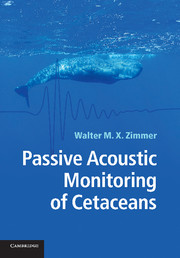Book contents
- Frontmatter
- Contents
- Acknowledgements
- Introduction
- Part I Underwater acoustics (the basics)
- Part II Signal processing (designing the tools)
- 4 Detection methods
- 5 Classification methods
- 6 Localization and tracking
- Part III Passive acoustic monitoring (putting it all together)
- References and further reading
- Index
4 - Detection methods
Published online by Cambridge University Press: 26 April 2011
- Frontmatter
- Contents
- Acknowledgements
- Introduction
- Part I Underwater acoustics (the basics)
- Part II Signal processing (designing the tools)
- 4 Detection methods
- 5 Classification methods
- 6 Localization and tracking
- Part III Passive acoustic monitoring (putting it all together)
- References and further reading
- Index
Summary
This chapter presents and discusses techniques that are commonly used to detect signals in passive sonar applications. Detection algorithms generate, from acoustic raw data, the information that is required by the subsequent steps in the PAM data processing chain.
Starting with the detection concept as presented in Chapter 3 to introduce the sonar equation, this chapter discusses first the standard ‘threshold’ detector, which is implemented in different flavours, and introduces then the ‘sequential probability ratio detector’, which is a non-linear recursive detector that has found increasing interest in sonar systems research.
Strongly related to the detection process is the selection of a proper method for reducing unrelated noise content by spectral filtering. This volume concentrates on major techniques found in the relevant literature: spectral equalization, bandpass filtering and matched filtering.
All detection methods are tested with real data and the performance differences are discussed. Parallel to the detection performance this chapter will address the issue of false alarms and discuss the Receiver Operation Characteristics (ROC) curves of detectors.
Detection of echolocation clicks
A PAM application may receive a time series similar to the one depicted in Figure 4.1, where we see 3 seconds' worth of data of an hour-long reception of underwater sound received on a single hydrophone. The figure shows a sequence of short transients embedded in a continuous noise floor as measured by the hydrophone.
- Type
- Chapter
- Information
- Passive Acoustic Monitoring of Cetaceans , pp. 119 - 163Publisher: Cambridge University PressPrint publication year: 2011
- 1
- Cited by



